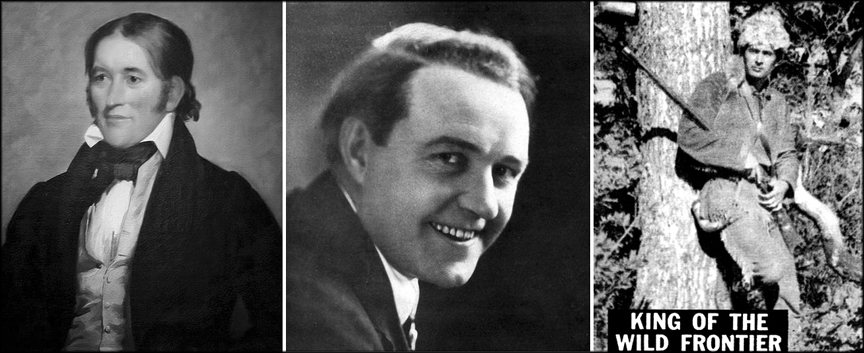The 1916 black and white silent film version of Davy Crockett was a dramatic contrast to the 1950's Technicolor one.

L to R: The Real Davy Crockett, The 1916 Movie One, The 1950's Television Crockett
The 1916 movie starred American singer, dancer and actor, Dustin Farnum, as Davy and Winifred Kingston as his sweetheart and future wife, Eleanor Vaughn (fictitional). The distribution company, Paramount Pictures and the production company, Pallas Pictures produced a 50-minute movie on five 10-minute reels.
Crockett, in name and reputation, conjures up the image of a tall, brave mountaineer, ready at any given moment to tackle anything that could be thrust upon him on the ground or through the air. Although Davy was somewhat famed as a hardy huntsman, in the Pallas picture, he was portrayed more as a lover than a fighter, in spite of the fact that he could not overcome his shyness around women. Although he found it impossible to tell Eleanor how much he loved her, his acting as a lover was made creditable. That would have been more the case had the Pallas script used an earlier version that was released as an opera.
Critics that year noted that there could not have been a better actor to act portray Crockett than 42-year-old Farnum. Although he performed three heroic scenes during the 50 minute production in accepted style, that was about all the film had to offer its expectant audiences. For the rest of the motion picture, the actor was mushy at times, working with a story line that was soggy plus an elongated unrelated side narrative that distracted from the intended subject.
In one scene, a scheming gambler planned to ensnare Eleanor, who was the daughter of a wealthy southern gentleman. The character was played by Page Peters, who tragically drowned soon after the film was released. To see Peters alive in action on the big screen, knowing that he was deceased, suggested a possible money-making opportunity. Families of fair means could have its members individually filmed with just enough footage to revive them later from the grave, allowing them to live forever on celluloid. The idea apparently never materialized.
Hoping to inspire Davy, Eleanor read a book titled Lochinvar to him. It was a fictional romantic hero of the ballad “Marmion” (1808), written in 1808 by Sir Walter Scott. However, even a famous romantic poem about a man who saved the woman he loved from marrying someone else made little impression on Crockett.
Soon after, another suitor who was interested in Vaughn's family sizable fortune advanced to the screen and began courting the impatient Eleanor. Even though she loved Davy, she agreed to marry the man, but on the wedding day, Davy decides to call out Lochinvar from England and transport him to the wild frontier. Just before the bride and groom exchanged marriage vows, Davy grabbed his prize, whisked her away and soon married her.
In other action, Crockett was attacked outside his cabin by a pack of ravenous wolves. Using his bare arm as a door brace, he displayed extraordinary bravery that highly impressed his audiences. Later, Farnum expertly broke an unruly horse and, in doing so, performed some fine bronco riding to the delight of his fans. Another scene found the actor expertly trapping a bear.
In summary, the movie's scenic surroundings were very entertaining and were it not for a somewhat drawn-out and padded story, this “Davy Crockett” production could have been a film disaster. It was the opinion of a reviewer that, with Farnum playing the lead role, the possibilities existed for another film of similar title and plot that learned from the failures of the first one. The critic encouraged Pallas to pursue another Davy Crockett movie along more active lines.
Something conspicuously absent in the 1916 version was the hit song from the 1950s titled, The Ballad of David Crockett.” It was recorded by several singers, but Bill Hayes's version became the most popular.

Comments are closed.